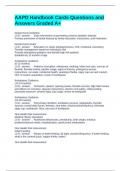AAPD Handbook Cards Questions and
Answers Graded A+
Dental Home Definition
(1-5) - answer Early intervention at preventing common pediatric disease
Primary prevention of dental disease by family education, instructions, and motivation
Dental Home Goals
(1-5) - answer Education on caries etiology/process, OHI, nutritional counseling
Fluoride management based on individual's risk
Provide anticipatory guidance and identify high risk patients
Establish by 12 months of age
Anticipatory Guidance
(6-12 months)
(1-5) - answer Patterns of eruption, milestones, teething, infant oral care, sources of
fluoride, fluoride toxicity, pacifier usage, signs of trauma, emergency access
instructions, car seats, nutritional health, weaning of bottle, sippy cup use and content,
OHI, S mutans acquisition, smear of toothpaste
Anticipatory Guidance
(12-24 months)
(1-5) - answer Occlusion, speech, spacing issues, fluoride sources, digit habit issues
and effects on occlusion, daycare instructions, electric cord safety, child proofing,
juice/carb exposure, decline sippy cup usage, smear of toothpaste
Anticipatory Guidance
(24-36 months)
(1-5) - answer Full primary dentition, exfoliation process, radiographs, fluoride
sources, revisit habit issues, helmets, seat belts, snacks/carbs/frequency, eliminate
sippy cup, toothbrush, floss, pea size of toothpaste
Oral Health Risk Assessment
Medical History Questions
(1-5) - answer Nutritional deficiencies, prematurity, birth weight, medical
problems/special needs, hospitalization, past/current medications
Oral Health Risk Assessment
Infant Feeding
(1-5) - answer Breast vs bottle feeding, @ night, duration/frequency, if bottle feeding,
what is the content (juice, sugary drinks, water)
Oral Health Risk Assessment
, Oral Hygiene Questions
(1-5) - answer Brushing, frequency/duration, who brushes the child's teeth, any
problems with cooperation and/or positioning
Oral Health Risk Assessment
Dietary Habits Questions
(1-5) - answer Eat sweets >2x/day, frequency, sippy cup vs open cup, daily amount
of juice, sugary drinks
Oral Health Risk Assessment
Fluoride Adequacy Questions
(1-5) - answer Main water source (city, bottle, well, Brita filter), fluoride level in the
water being consumed (0.7ppm optimal), Fluoride supplements, use fluoridated
toothpaste, amount of toothpaste used
Taurodontism - answer *Failure of normal invagination of Hertwig's epithelial root
sheath
*incidence 0.54-5.6%
*elongation of crown at the expense of the roots
****LARGE PULPS****
Syndromes with Taurodontism - answer *Klinefelter Syndrome(in 30%)
*Tricho-dento-osseus syndrome(TDO)--have periapical radiopacities &high pulp horns
*Mohr Syndrome(Orofaciodigital syndrome II)
*Ectodermal Dysplasia
*Down Syndrome
*Amelogenesis Imperfecta,Type IV(hypomaturation-hypoplastic type)
*Dilaceration(lamellar congenital icthyosis)
Amelogenesis Imperfecta(Anomaly of Structure--HISTODIFFERENTIATION) - answer
*heritable enamel defect
*incidence variable 1:14,000(generally accepted),1:8000,1:4000
*Multiple inheritance patterns
*14 subgroups under 4 major types
*distinguished from other enamel defects: confinement to distinct patterns of
inheritance; occurrence apart from syndromic, metabolic, or systemic condition
AI Type I-Hypoplastic - answer *insufficient quantity of enamel
*both dentitions affected
*most common subgroup: Autosomal Dominant(AD)
*anterior open bite in 44%
Subgroups:
*pitted:AD
*localized: AD, AR(autosomal recessive)
*smooth: AD, X-linked(X)
*rough: AD




